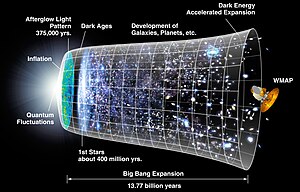While the Big Bang model is well established in cosmology, it is likely to be refined in the future. Little is known about the earliest moments of the Universe's history. The Penrose-Hawking singularity theorems require the existence of a singularity at the beginning of cosmic time. However, these theorems assume that general relativity is correct, but general relativity must break down before the Universe reaches the Planck temperature, and a correct treatment of quantum gravity may avoid the singularity.
Some proposals, each of which entails untested hypotheses, are:
- models including the Hartle–Hawking no-boundary condition in which the whole of space-time is finite; the Big Bang does represent the limit of time, but without the need for a singularity.
- brane cosmology models in which inflation is due to the movement of branes in string theory; the pre-big bang model; the ekpyrotic model, in which the Big Bang is the result of a collision between branes; and the cyclic model, a variant of the ekpyrotic model in which collisions occur periodically. In the latter model, the Big Bang was preceded by a Big Crunch and the Universe endlessly cycles from one process to the other.
- chaotic inflation, in which universal inflation ends locally here and there in a random fashion, each end-point leading to a bubble universe expanding from its own big bang.

Proposals in the last two categories see the Big Bang as an event in a much larger and older Universe, or multiverse, and not the literal beginning.
Religious interpretations
The Big Bang is a scientific theory, and as such is dependent on its agreement with observations. But as a theory which addresses the origins of reality, it has always carried theological and philosophical implications. In the 1920s and 1930s almost every major cosmologist preferred an eternal steady state Universe, and several complained that the beginning of time implied by the Big Bang imported religious concepts into physics; this objection was later repeated by supporters of the steady state theory. This perception was enhanced by the fact that the originator of the Big Bang theory, Monsignor Georges Lemaître, was a Roman Catholic priest Pope Pius XII, declared at the November 22, 1951 opening meeting of the Pontifical Academy of Sciences that the Big Bang theory accorded with the Catholic concept of creation.
Since the acceptance of the Big Bang as the dominant physical cosmological paradigm, there have been a variety of reactions by religious groups as to its implications for their respective religious cosmologies. Some accept the scientific evidence at face value, while others seek to reconcile the Big Bang with their religious tenets, and others completely reject or ignore the evidence for the Big Bang theory.
The future according to the Big Bang theory
Before observations of dark energy, cosmologists considered two scenarios for the future of the Universe. If the mass density of the Universe were greater than the critical density, then the Universe would reach a maximum size and then begin to collapse. It would become denser and hotter again, ending with a state that was similar to that in which it started—a Big Crunch. Alternatively, if the density in the Universe were equal to or below the critical density, the expansion would slow down, but never stop. Star formation would cease as all the interstellar gas in each galaxy is consumed; stars would burn out leaving white dwarfs, neutron stars, and black holes. Very gradually, collisions between these would result in mass accumulating into larger and larger black holes. The average temperature of the Universe would asymptotically approach absolute zero—a Big Freeze. Moreover, if the proton were unstable, then baryonic matter would disappear, leaving only radiation and black holes. Eventually, black holes would evaporate by emitting Hawking radiation. The entropy of the Universe would increase to the point where no organized form of energy could be extracted from it, a scenario known as heat death.
Modern observations of accelerated expansion imply that more and more of the currently visible Universe will pass beyond our event horizonand out of contact with us. The eventual result is not known. The ΛCDM model of the Universe contains dark energy in the form of acosmological constant. This theory suggests that only gravitationally bound systems, such as galaxies, would remain together, and they too would be subject to heat death, as the Universe expands and cools. Other explanations of dark energy—so-called phantom energy theories—suggest that ultimately galaxy clusters, stars, planets, atoms, nuclei and matter itself will be torn apart by the ever-increasing expansion in a so-called Big Rip.

No comments:
Post a Comment